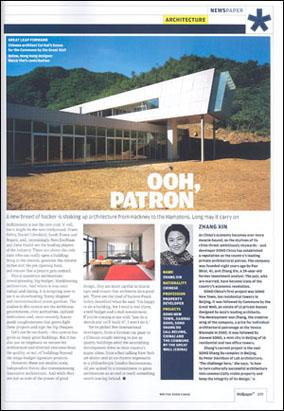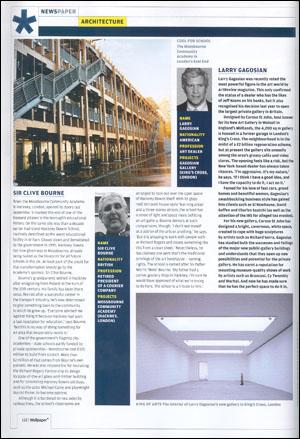

A new breed of backer is shaking up architecture from Hackney to the Hamptons. Long may it carry on
Architecture is not the new rock'n' roll, but it might be the new Hollywood. Frank Gehry, Daniel Libeskind, Lords Foster and Rogers, and increasingly, Rem Koolhaas and Zaha Hadid are the leading players of the industry. These are above-the-title stars who can really open a building: bring in the crowds, generate the column inches and the pre-opening buzz, and ensure that a project gets noticed.
This is statement architecture: crowd-pleasing, big- budget, blockbusting architecture. And where it was once radical and daring, it is tempting now to see it as showboating 'funny shapism' and institutionalized avant-gardism. The studios in this system are the ambitious governments, civic authorities, cultural institutions and, more recently, luxury goods conglomerates that green-light these projects and sign the big cheques.
Let's not be too harsh-this system has given us many great buildings. But is has also put an emphasis on instant-hit architecture and diverted attention from the quality, or not, of buildings beyond the mega-budget signature projects.
However, there are smaller-scale, independent forces also commissioning innovative architecture. And while they are just as sure of the power of good design, they are more careful to rein in egos and ensure that architects do a good job. These are the kind of backers Frank Gehry described when he said: 'I' m happy to do a building, but I need a real client, a real budget and a real commitment. If you're coming at me with "just do a sketch and we'll build it", I won't do it '
We've picked five international developers, from a German car giant to a Chinese couple striving to put up quality buildings amid the astonishing development drive in their country's major cities, from a fast-talking New York art dealer and an ex-theatre impresario to a philanthropic London businessman. All are united by a commitment to great architecture as an end in itself, something worth leaving behind.
ZHANG XIN
As China's economy becomes ever more muscle-bound, so the skylines of its cities thrust ambitiously skywards-and developer SOHO China has established a reputation as the country's leading private architectural patron. The company was founded eight years ago by Pan Shiyi, 41, and Zhang Xin, a 39-year old former investment analyst. The pair, who are married, have become icons of the country's economic revolution.
SOHO China's first project was SOHO New Town ten residential towers in Beijing. It was followed by Commune by the Great Wall, an estate of 12 private houses designed by Asia's leading architects. The development won Zhang, the creative wing of the company, a prize for individual architectural patronage at the Venice Biennale in 2002. It was followed by Jianwai SOHO. a mini city in Beijing of 18 residential and two office towers.
Zhang's current project is the vast SOHO Shang Du complex in Beijing by Peter Davidson of Lab Architecture. 'The challenge here,' she says, 'is how to turn culturally successful architecture into commercially viable property and keep the integrity of its design.'
NAME
ZHANG XIN
NATIONALITY
CHINESE
PROFESSION
PROPERTY DEVELOPER
PROJECTS
SOHO NEW TOWN, JIANWAI SOHO, SOHO SHANGDU (ALL BEIJING CHINA) AND THE COMMUNE BY THE GREAT WALL (CHINA)
COCO BROWN
 Where the Hamptons was once dotted with mid-century modernist houses in wood and glass,the area is now full of shingle-style mansions that echo the porches and gables of traditional 19th-century American housing.One man believes it's time to get back to building more discreet and modernist housing in the area.
Where the Hamptons was once dotted with mid-century modernist houses in wood and glass,the area is now full of shingle-style mansions that echo the porches and gables of traditional 19th-century American housing.One man believes it's time to get back to building more discreet and modernist housing in the area.In the mid-1990s,theatre producer Harry 'Coco'Brown acquired 100 acres of scrubland in an unfashionable part of the Hamptons. 'I thought, "Why sell it off to developers when I could create something better?"' he says. He hired Richard Meier as an advisor and together they drew up a dream team of contemporary architects. Unsurprisingly, few could resist the offer. Today, the Houses at Sagaponac project boasts plans for 34 houses designed by the likes of Shigeru Ban. Henry Cobb, Zaha Hadid and Richard Rogers.
The asking price for the first completed house, by sisters Gisue and Mojgan Hariri, is around $3 million. A bargain in the Hamptons - where, in 2000, Jerry Seinfeld paid $22 million for a villa. Interest in the project is high and five other houses are mow being constructed. One - designed by Henry Cobb - has already been sold.
You might imagine that Brown would want a healthy financial return, but he insists that his motivation is creative. 'I don't see myself as a developer,' he says. 'I've always bought art and I don't see this as any different. If you walk down the street you'll go past a house by Zaha Hadid, then one by Philip Johnson or Richard Rogers. To me, this is an art project.'
NAME
HARRY 'COCO' BROWN
NATIONALITY
AMERICAN
PROFESSION
THEATRE PRODUCER
PROJECTS
THE HOUSES AT SAGAPONAC (NEW YORK)
BMW
If grand architectural statements by public institutions can seize the public imagination, then why can't car manufacturers use similar methods to similar ends? That seems to be the question Germany's leading automobile brands are asking themselves at the moment.
Volkswagen has recently opened the Glass Factory in the centre of Dresden, a dazzling 140 million edifice that's equal parts assembly plant, attraction and advertisement for VW's new luxury saloon, the Phaeton. In Leipzig, Porsche has built a 115 million factory-cum-showroom for its Cayenne off-roader. Towering over the site is 'the diamond', a glowing 30m-high cylindrical customer centre that resembles a spacecraft. Most spectacular of all is BMW's 1.15 billion new assembly plant for its 3 Series car. Currently under development in Leipzig, it is Europe's largest construction project and has an administration building designed by Zaha Hadid. By the time it's completed in 2005, it will feature cavernous spaces and ceiling-mounted assembly lines that shuttle half-built cars past offices of company staff.
The Leipzig complex is only one of two major architectural ventures BMW is currently undertaking. Within sight of the company's famous Four Cylinders headquarters in Munich (now undergoing major renovation),the award-winning Austrian architectural practice Coop Himmelb(l)au has been commissioned to design BMW Welt, a futuristic visitor centre with a sculptural roof, where customers can come to pick up their new cars and marvel at 'what the art of BMW really means'.
To find the last time car manufacturers invested this amount of money in their buildings you'd have to go back to the 1930s, when cars were a relatively new invention and the factories that built them were vast 'motor palaces.' The new prestige sites are proof of a commitment to design integrity in all areas. In truch, with less and less to differentiate between rival models(accepting that designer Chris Bangle has given the BMW range a radical new language of sharp lines and jaunty angles), companies have increasingly relied on branding to establish their uniqueness. In BMW's case this has meant producing a series of short film by the likes of John Frankenheimer, Ang Lee and Wong Kar Wai, and, now, commissioning buildings from some of the world's most innovative architects.
For Hadid, whose designs frequently get no further than the drawing board, the Leipzig project means a chance to finally test her architectural language on a large, functional building. 'This project is a wonderful opportunity for us to transform movement into architecture,' she says.
 SIR CLIVE BOURNE
SIR CLIVE BOURNEWhen he Mossbourne Community Academy in Hackney, London, opened its doors last September it marked the end of one of the bleakest phases in the borough's educational history. On the same site less than a decade earlier had stood Hackney Dwons School, routinely described as the worst educational facility in Britain. Closed down and demolished by the government in 1995, Hackney Downs has now given way to Mossbourne., already being hailed as the blueprint for all future schools in the UK. At least part of the credit for that transformation should go to the Academy's sponsor, Sir Clive Bourne.
Bourne's grandparents settled in Hackney after emigrating from Poland at the turn of the 20th century. His family has been there since. Retired after a successful career in the transport industry, he's now determined to give something back to the community in which he grew up. 'Everyone advised me against doing it because Hackney had such a bad reputation for education,' says Bourne. 'But this is my way of doing something for an area that desperately needs it.' One of the government's flagship city academies - state schools partly funded by private sponsorship - Mossbourne cost 325 million to build from scratch. More than 2 million of that comes from Bourne's own pockets. He was also responsible for recruiting the Richard Rogers Partnership to design its state-of-the-art glass-and-timber building and for convincing Hackney Downs old boys, such as the actor Michael Caine and playwright Harold Pinter, to become patrons.
Although it is bordered on two sides by railway lines, the school's classrooms are arranged to look out over the open space of Hackney Downs itself. With its glass roof, terraced house-style 'learning areas' and a three-storey atrium, the school has a sense of light and space more befitting an art gallery. Bourne demurs at such comparisons, though. 'I don't see myself as a patron of the arts or anything.' he says. 'But it is amazing to work with people such as Richard Rogers and create something like this from a clean sheet.' Nevertheless, he has claimed one perk that's the traditional privilege of the art benefactor - naming rights. The school is named after his father Morris 'Moss' Bourne. 'My father had a corner grocery shop in Hackney. I'm sure he would have approved of what we're trying to do her. The school is a tribute to him.'
NAME
SIR CLIVE BOURNE
NATIONALITY
BRITISH
PROFESSION
RETIRED PRESIDENT OF A COURIER COMPANY
PROJECTS
MOSSBOURNE COMMUNITY ACADEMY (HACKNEY, LONDON)
LARRY GAGOSIAN
Larry Gagosian was recently voted the most powerful figure in the art world by ArtReview magazine. This only confirmed the starts of a dealer who has the likes of Jeff Koons on his books, but it also recognized his decision last year to open the largest private gallery in Britain.
Designed by Caruso St John, best known for its New Art Gallery in Walsall in England's Midlands, the 4,200 sq m gallery is housed n a former garage in London's King's Cross. The neighbourhood is in the midst of a 2 billion regeneration scheme, but at present the gallery sits uneasily among the area's greasy cafes and video stores. The opening feels like a risk, but the New York-based dealer has always taken chances. 'I' m aggressive. It's my nature,' he says. 'If think I have a good idea, and I have the capacity to do it, I act on it.'
Famed for his love of fast cars, grand homes and beautiful women, Gagosian's swashbuckling business style has gained him clients such as Si Newhouse, David Geffen and Charles Saatchi (as well as the attention of the IRS for alleged tax evasion).
For his new gallery, Caruso St John has designed a bright, cavernous, white space, created to cope with huge sculptures by artists such as Richard Serra. Gagosian has studied both the successes and failings of the major new public-gallery buildings and understands that they open up new possibilities and potential for the private gallery. He has earnt a reputation for mounting museum-quality shows of work by artists such as Brancusi, Cy Twombly and Warhol. And now he has made sure that he has the perfect space to do it in.
NAME
LARRY GAGOSIAN
NATIONALITY
AMERICAN
PROFESSION
ART DEALER
PROJECTS
GAGOSIAN GALLERY (KING'S CROSS, LONDON)





